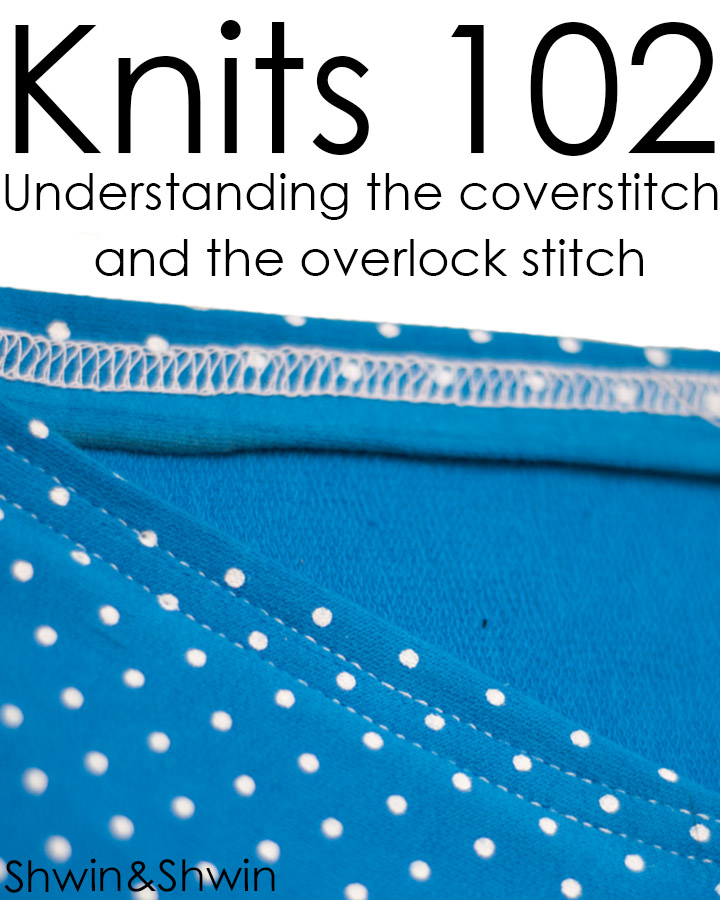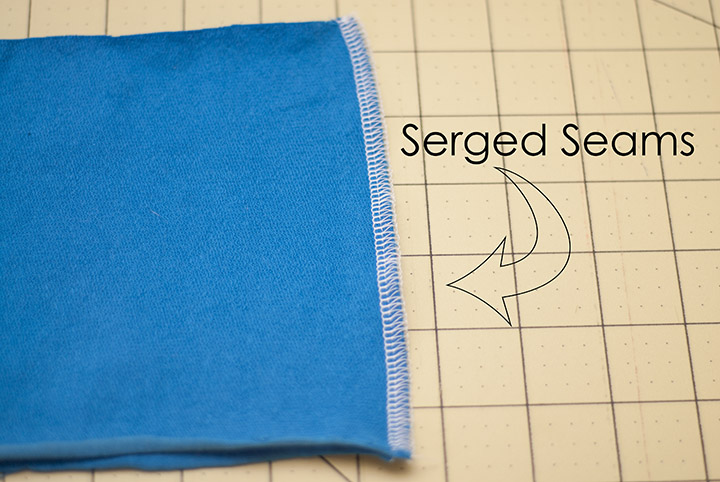I love sewing with knits, which is nice because I love wearing knits, and my kids love wearing knits. However I used to HATE sewing with knits and it was simply because I didn’t know how. Knits are different for sure, but they aren’t so bad and once you figure things out you will be whipping through knits like nobody’s business. So a while back I shared my Knits 101 post, and Ribbing 101, and today I am sharing all about the cover stitch and the overlock stitch. Both require special machines, but you don’t need special machines to sew with knits, they can just be helpful.
The cover stitch is the double (or triple) stitch used for hemming knits or topstitching seams that need stretch. You see even though it looks like a straight stitch it stretches with the knit, you know so you don’t hear that horrible “pop” sound when you try on a shirt and all the seams and hems that should stretch but don’t start to bust open. (I have had that happen more than I care to admit)
To do a cover stitch you will need either a cover stitch machine, or a serger that has a cover stitch option. (see the buying guide below for more info) To sew the cover stitch you place the fabric right at the needles (just like when you are sewing)
When you get to the end of the fabric you lift the presser foot and pull the fabric away instead of “over sewing” like you would when you use a serger.
What you are left with is a double stitch on one side and the chain stitch on the back side which allows for the stretching of the seam. If you check out any knit tee, skirt, dress, legging from the store they will all be hemmed this way. So it allows for a great professional finish when sewing at home.
Next up the serged seam. You may hear people saying all the time that they were able to make a knit top super quick only using their serger. How is this possible? Well much like the cover stitch a serged seam stretches and if your tension is set properly you should get a nice tight seam. A serger sews much faster than a sewing machine, and it feeds the fabric through nice and smooth so it’s fun and easy to use when sewing with knits and it does make it easier.
With the serger you start sewing and then feed your fabric through, and continue “chaining off” before cutting your fabric loose. The stitch will wrap around the edge of the fabric.
You are left with a nicely stitched seam. No need to do anything else.
The seam will stretch which again avoids that pop that dreaded, dreaded pop. (also it’s clearly not a good idea to take tutorial pictures after scrubbing a bathroom all day and loosing half my nail polish, but whatever)
So now that we have discussed the stitches, let’s talk machines…
*disclosure I am simply sharing my advice, and opinions I have not received any machines or money from any company nor is this post being sponsored by any brand*
Serger/Cover stitch in one
Pros:
- All in one means one machine so less clutter at the sewing table.
- You only have to buy one machine
- You only have to learn about one machine which means reading one manual
Cons:
- You do have to completely re-thread and change the settings and needle placement, which is not super easy
- You have to be smart about assembly since you don’t want to switch back and forth for every seam
- You have to re-thread to switch (I hate that enough it was worth mentioning twice)
2 in one Machine:
I recently got the Baby Lock Diana
I love it, I decided on the Diana since I was in need of a new serger I had been using an old Elna and while I loved it for seam finishing I was never able to get the tension setting tight enough so my seams were always pulling apart, I don’t have that problem with the Diana.
Separate Serger and Cover Stitch Machine:
Pros:
- No need to switch the threading of the machine.
- You can quickly and easily sew knits with both stitches
Cons:
- You have to buy two machines
- You would have two machines on your sewing table taking up space
Serger:
The Baby Lock Enlighten will cost a pretty penny but comes highly recommended.
The Brother 1034d comes with a smaller price tag and those who use it love it.
Cover stitch Machine:
There is the Janome Coverpro 900CPX is a machine with a decent price and is cover stitch only. I don’t know how well it works since I don’t know any reviews on a cover stitch only machine but the Janome seems like a decent option.
For more knit tips and posts for sewing with knit fabrics check out:
See Kate Sew
Melly Sews
Andrea’s Notebook
We are all sharing posts today to help with sewing with knits while making the Just Add Jeans collection of tops. If you haven’t picked up your collection yet you should the collection Ends Monday the 24th! (currently 40% off retail!)









Vanessa
Thank you for this post! I have a serger, but I have my eye on a coverstitch machine for more professional results. I have been using a twin needle on my sewing machine for now, but it gives results that are o.k. for now.
Shauna@shwinandshwin
I used my sewing machine for years, the results were fine but it was amazing to me how much more stretch you get in a cover stitch. I just love that there are so many options and that you can work up to new things.
Christina
Great post! I've often had questions and wondered about using my serger (Brother 1034D and I love it too!) to sew my knit garments. I have it set to one needle with 3 threads. Honestly, it's super intimidating and I set it like this early on and I'm afraid to mess with it! I think I will if it will help me sew knits!
Shauna@shwinandshwin
I know! Sergers can be so intimidating! When I get mine set just right it stays that way for several months since I am afraid to touch it in fear of messing it up, but the more I work with it the more comfortable I am getting.
hey june
Susan and I both have the Brother Coverstitch and we love it! It works like buttah 🙂
Dani @ The Domestic Darling
Great post on knit sewing! It really is amazing how many people say how scary knits seem until you know how and then fall in love with sewing with them. A cover lock is right at the top of my wish list right now but in Australia they are sooo expensive compared to a regular serger or sewing machine (boo to inflated Aussie prices!)
Jennifer
Great post! Thanks for the great info. When you serge your seams, do you first stitch them together with your regular sewing machine & then serge or just serge them? I got a serger for Christmas & love it but am still a little intimidated by it!
Kerri Steenbeeke
no, you just serge them…
johanna@projects by me
About cover hem machines, I recently discussed those with the salesman at my local sewing machine store. They mostly sell HusqvarnaViking machines, but also Pfaff and Singer, but when it came to cover hem machines he recommended Janome 1000CPX, which he doesn't even sell!!! Just a tip! Then I heard somewhere else that the Elna coverhem machine and the Janome 1000CPX really are the same!
Kerri Steenbeeke
What does a domestic coverstitch and overlocker machine cost in Australia?
I was thinking of replacing my industrial collarette machine (it skips stitches sometimes…) with a domestic (but have no clue what brand to look at…), but with all the factories closing down it might be cheaper to buy a ‘younger’ ex-factory industrial… I am blessed with a husband who built me a triple garage size shed that I only have to share with some storage, so am able to house my collection of various sewing machines 😉
Laurie
Thank you for this helpful post! I’m very new to sewing with knits and trying to learn everything I can about using my serger and coverstitch machine for them, so this is great. One question–When using the coverstitch, do I need to do anything to prevent the ends of the thread from unraveling? Or just cut off the excess? Thanks again!
Barb
Great info, thanks. Do you use wooly nylon in the loopers?
Ruth
Hi there, thank you for this post. I’m in the process in getting a cover stitch machine but I’m worried about how I’m going to be able to keep the material down evenly while I sew? Since I won’t be able to keep a eye on what’s going on at the bottom of the material.
Liana
Hello and thank you for helping me finally understand the difference between these two important stitches. You mentioned that there are some sergers that can fake coverstitches. What features must those sergers have, is it the flatlock feature by any chance, or something else? I am a novice sewist who loves wearing knits, so I would love to buy a serger, but a serger + a coverstitch is way out of my budget, so if I could find a serger that can do both (even if faling the coverstitch, I’m thinking it would still be better than the double needle sewing machine hack), I would be thrilled. Thank you again and happy sewing!
Shauna
Good question! I recently purchased a secondary coverstitch (juki 1000) since I was annoyed with converting the serger in the middle of a project. Oddly though I still rarely use it. I sew 90% of the project on the serger, (regular overlock seam 4 thread) and then depending on the knit I will either hem it on my sewing machine with a single needle, or that’s when I will pull out the coverstitch for the hem. My advice to anyone would be to get the best serger you can afford, you won’t ever be sorry you have one. If the day comes that you have extra money and you want to expand your skills go for a coverstitch. I thought it would be life changing but really all it does is hems and that’s something my other machines could do as well, but now when I hem I have to find 4 spools of matching thread. Hope that helps!